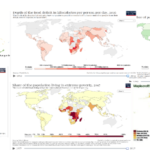Naïvely I used to think that sustainability was just about a program finding another funding source when the previous funding was coming to an end. The only other examples that I recall about sustainability were stories about international development projects that, for example, built a water pump in a village in a far-away country and then after the project implementers left, the water pump eventually broke but no one in the community knew how to fix or maintain the pump — so the benefits from the project were not sustained. Such examples hinted at the notion that gains had been made, but they could not be sustained over time, partially due to poor planning.
I finally got a clearer, fuller picture of what sustainability is about while writing a paper in 2019,
Canadian Journal of Evaluation, 2019
This blog is about some of the lessons we learned in thinking about sustainability and the roles for evaluation in helping better ensure that gains made by projects/initiatives can be sustained.
What basically is sustainability?
Sustainability can be thought of in three ways: 1) sustaining components of the intervention, 2) sustaining impacts after the program ends, and 3) mainstreaming or incorporating active ingredients of the intervention into other programs.
Program vs Client Point-of-Views
In my observation, evaluators, planners, program managers and staff tend to conceive of the impacts of a program very much from the viewpoint of the program – in terms of its activities and outputs that presumably lead to the intended outcomes. But if we consider a program’s impact from the frame of a client/ intended program recipient, most clients intersect only at points with a program while the rest of the time they are outside from the program living their lives. The “impact journey” typically encountered by a client rarely takes the form of a linear trajectory through one program but is one of a “rugged landscape” where many hills need to be climbed, circuitous pathways navigated, rivers crossed to reach the promised land of impacts. The program may only partially help progress the client along their impact journey. In planning programs, one needs to consider what else may be needed for clients to eventually reach the promised land, or at least what else is needed to sustain the gains achieved.
In evaluation terms, this translates to a change in focus from more direct and immediate program impacts to more sustained impacts that take into account the complex and heterogeneous needs of clients/program recipients.
Risk Landscapes of Clients
The metaphors of heterogeneous landscapes and multiple hills that are involved in clients’ journeys toward achieving goals/outcomes are useful reminders of the risk landscapes that remain for clients to contend with even after the intervention ends. In our experience, programs typically end without sufficient attention paid in advance to the provision of resources or continuity of care to clients, or to implementing strategies to better ensure that the outcomes achieved during the intervention can be maintained after the program ends. Knowledge of clients’ heterogeneous impact journeys and what context of supports, capacities, opportunities, and motivational incentives they might need after the program ends to at least retain the gains achieved and hopefully stay on the journey can inform strategies that envision what needs to be in place. For example, what needs to be in place might include partnerships with other agencies that have the capacity to carry on, or equipping participants with needed capabilities and resources to carry on themselves. In some scenarios, it might be preferable for a program to divert funds from serving a larger number of clients and taking them halfway across the river, to reallocating resources in order to take a fewer number of clients all the way across the river.
What changes when planning for sustainability?
When you plan for sustainability, your intervention’s theory of change and program activities will be different than if you plan only for outcomes within the intervention’s sphere of control and influence. For example, there have been multitudes of exercise programs studied in the literature that show good results of attendance, compliance, improved health outcomes, etc., but after the program ends the participants stop exercising, so maintenance of the healthy gains dissipates. Some of the reasons given by participants include: no gyms or green spaces in their neighbourhood, lack of transportation to get to gyms, other exercise class times are not convenient, not feeling safe to exercise alone, and loss of motivation. If we know all of this, then a typical exercise program should be changed from simply leading participants through the best set of exercises to also teaching participants how to exercise on their own, helping them to understand what affects motivation, structuring exercise sessions so that endorphins (natural feel-good chemicals in the brain) kick in, reinforcing how good exercise feels so that participants start associating exercising with feeling good and will be more driven to continue. The intervention changes based on considerations of what clients will typically encounter in their journey beyond the intervention and what it would take to sustain them in that journey.
Planning for sustainability should be an integral part of what we consider to be a useful theory of change. Incorporating planning for sustainability can change the nature of the program itself (Sridharan & Gillespie, 2004).
Finally, here are tips and considerations for developing a theory of change to incorporate sustainability planning:
- Make explicit the uncertainties in the theory of change
- Map the connections between the intervention and the rest of the organizational system
- Explore the heterogeneities of client-level needs
- Explore key barriers that individuals will face in the intended impact journey
- Explore the potential timelines of impact
- Explore the dynamic context of supports needed both during and post-funding stages to assist with capabilities, opportunities, and motivational incentives
- Explore the role of boundary partners



